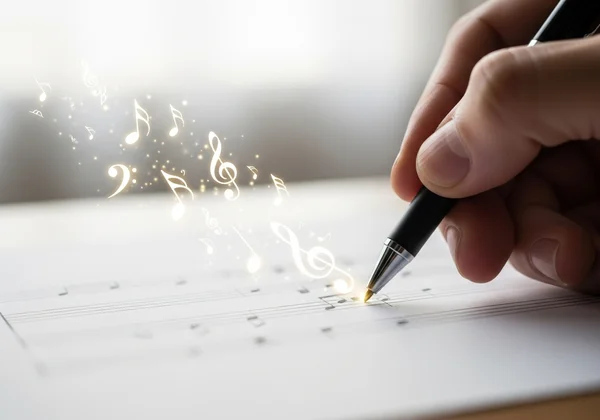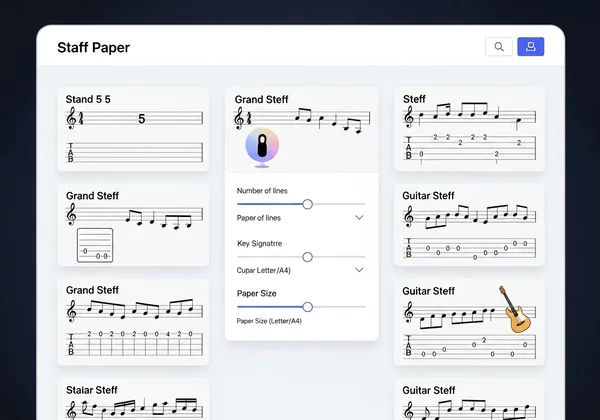प्रिंट करने योग्य स्टाफ पेपर पर रचना: धुन के लिए आपके पहले कदम
अपने संगीत विचारों को खोलें! क्या कभी कोई धुन आपके दिमाग में अटकी है और आपको उसे लिखना नहीं आया? अपने संगीत विचारों को जीवंत बनाने के लिए अपना स्टाफ पेपर कैसे बनाएं? यह गाइड महत्वाकांक्षी संगीतकारों और गीतकारों को बताएगा कि कैसे वे खाली स्टाफ पेपर का उपयोग करके प्रेरणा की उन चिंगारियों को मूर्त संगीत में बदल सकते हैं, जिससे संगीत लेखन हर किसी के लिए सुलभ हो सके। सही उपकरणों और थोड़े से मार्गदर्शन के साथ, आप अपनी रचनात्मक ऊर्जा को साझा करने योग्य गीतों में बदल सकते हैं। रचना शुरू करने के लिए तैयार हैं? हमारे मुफ्त, अनुकूलन योग्य संसाधनों का उपयोग करके आज ही अपनी संगीत यात्रा शुरू करें!

अपने कैनवास को समझना: रचना के लिए स्टाफ पेपर की शक्ति
पांच-लाइन वाला स्टाफ संगीत की सार्वभौमिक भाषा है, और स्टाफ पेपर रचना का उपयोग करना किसी भी संगीतकार के लिए अपने विचारों को दर्ज करने के लिए मौलिक है। यह कागज पर आपके संगीत विचारों को देखने का एक स्पष्ट तरीका प्रदान करता है। चाहे आप एक साधारण धुन लिख रहे हों या एक जटिल ऑर्केस्ट्रा टुकड़ा बना रहे हों, सही कागज होने से बहुत फर्क पड़ता है।
अपनी धुन के लिए सही खाली शीट संगीत टेम्पलेट चुनना
इससे पहले कि आप शुरू करें, उपयुक्त खाली शीट संगीत टेम्पलेट का चयन करना महत्वपूर्ण है। विभिन्न वाद्ययंत्रों और संगीत संदर्भों के लिए स्टाफ पेपर के विशिष्ट प्रकारों की आवश्यकता होती है। उदाहरण के लिए, एक पियानो टुकड़ा को ग्रैंड स्टाफ की आवश्यकता हो सकती है, जबकि गिटार की धुन को मानक नोटेशन के साथ-साथ टैब्लेचर से भी लाभ मिलता है। हमारा प्लेटफ़ॉर्म गिटार, पियानो, बास और कोरस स्टाफ पेपर जैसे मानक स्टैवों से लेकर विशिष्ट प्रारूपों तक, प्रिंट करने योग्य स्टाफ पेपर टेम्पलेट्स की एक विविध श्रृंखला प्रदान करता है। आप प्रति पृष्ठ पंक्तियों की संख्या, कुंजी हस्ताक्षर, और यहां तक कि कागज का आकार (लेटर या ए4) भी अपनी परियोजना की जरूरतों से पूरी तरह मेल खाने के लिए अनुकूलित कर सकते हैं। बस अपने इच्छित प्रकार चुनें और अपने काम के लिए उसे पूरी तरह से अनुकूलित करके मुफ्त स्टाफ पेपर प्राप्त करें ।

आवश्यक तत्व: शुरुआती लोगों के लिए नोट्स, लय और संगीत रूप
वास्तव में धुन रचना करने के लिए, आपको उन मूलभूत तत्वों को समझने की आवश्यकता है जो संगीत को संचालित करते हैं। इनमें यह समझना शामिल है कि नोट्स पिच का प्रतिनिधित्व कैसे करते हैं, लय अवधि को कैसे निर्धारित करती है, और संगीत रूप संरचना कैसे प्रदान करता है। नोट्स को वर्णमाला, लय को शब्दों और संगीत रूप को अपनी संगीत कहानी के वाक्यों और पैराग्राफ के रूप में सोचें। अपने खाली संगीत स्टाफ पेपर पर इन मूल बातों को जानने से आपको अपने विचारों को स्पष्ट रूप से व्यक्त करने में मदद मिलेगी। यह वह तरीका है जिससे आपकी रचनाएँ पॉलिश की हुई लगने लगती हैं।
आपके पहले नोट्स: संगीत लिखने के लिए चरण-दर-चरण मार्गदर्शिका
अब जब आपके पास अपना एकदम सही स्टाफ नोटेशन पेपर है, तो आइए संगीत लिखने के व्यावहारिक पहलुओं पर ध्यान दें। अपने विचारों को कागज पर उतारने के लिए तैयार हैं? यह खंड दिखाता है कि आप अपने संगीत विजन को एक पठनीय स्कोर में कैसे बदल सकते हैं।
अपनी पिच खोजना: स्टाफ पर नोट्स रखना
संगीत लिखने का सबसे रोमांचक हिस्सा अपनी धुन को आकार लेते देखना है। स्टाफ पर प्रत्येक रेखा और स्थान एक विशिष्ट पिच से मेल खाता है। यदि आप शुरुआती हैं तो एक साधारण सी मेजर स्केल से शुरू करें, धीरे-धीरे स्टाफ पर ऊपर और नीचे जाएं। लय की जटिलता जोड़ने से पहले केवल पिच प्लेसमेंट पर ध्यान केंद्रित करने के लिए शुरू में पूरे नोट्स या आधे नोट्स का उपयोग करें। याद रखें, अपने संगीत विचारों को दूसरों और आपके भविष्य के लिए आसानी से समझा जा सके, यह सुनिश्चित करने के लिए नोट्स रखते समय स्पष्टता महत्वपूर्ण है!
अपनी धुन को जीवन देना: लय और मीटर को समझना
धुन केवल पिचों की एक श्रृंखला नहीं है; इसमें गति और ताल होती है। लय को समझना में यह जानना शामिल है कि विभिन्न नोट मान (पूरे, आधे, चौथाई, आठवें, आदि) प्रत्येक ध्वनि की अवधि को कैसे प्रभावित करते हैं। मीटर, टाइम सिग्नेचर द्वारा इंगित किया गया, आपको बताता है कि प्रत्येक माप में कितने बीट्स हैं और किस प्रकार का नोट एक बीट प्राप्त करता है। अपनी धुन को चौथाई नोट्स जैसे सरल लय के साथ रेखांकित करके शुरुआत करें, फिर दिलचस्पी और विशेषता जोड़ने के लिए धीरे-धीरे विभिन्न नोट मानों को पेश करें। यह वास्तव में आपकी स्टाफ पेपर पीडीएफ रचनाओं को जीवंत कर देगा।
अपनी धुन रेखा को आकार देना: समोच्च, वाक्यांश और अभिव्यक्ति
बुनियादी नोट्स और लय से परे, स्टाफ पेपर पर रचना की कला आपकी धुन रेखा को आकार देने में निहित है। इसमें समोच्च (धुन का उतार-चढ़ाव), वाक्यांश (संगीत विचारों को कैसे समूहीकृत किया जाता), और अभिव्यंजक चिह्नों को जोड़ना शामिल है। अपनी धुन को एक बातचीत के रूप में सोचें — आप इसे कैसे प्रवाहित करना चाहते हैं? इसे कहाँ सांस लेनी चाहिए? अपने संगीत के पीछे की भावना और इरादे को व्यक्त करने के लिए आवाज़ का उतार-चढ़ाव (तेज़ और धीमे स्वर), उच्चारण (नोट्स कैसे बजाए जाते), और टेम्पो परिवर्तनों के साथ प्रयोग करें। यह आपकी रचनाओं में गहराई की एक महत्वपूर्ण परत जोड़ता है।
संगीत गीत लेखन में चुनौतियों पर काबू पाना
यहां तक कि अनुभवी संगीतकार भी रचनात्मक अवरोधों का सामना करते हैं। संगीत गीत लेखन में अक्सर चीजों को आज़माना और बदलाव करना शामिल होता है, और यह बिल्कुल सामान्य है। कुंजी उन्हें दूर करने की रणनीतियाँ रखना और अपने रचनात्मक प्रवाह को जारी रखना है।
जब प्रेरणा मिले: स्टाफ पेपर पर विचारों को पकड़ने के लिए त्वरित युक्तियाँ
प्रेरणा क्षणभंगुर हो सकती है। यही कारण है कि आसानी से उपलब्ध स्टाफ पेपर आवश्यक है। हमेशा कुछ खाली स्टाफ पेपर पास रखें, या जब कोई विचार आए तो तुरंत हमारे साइट से स्टाफ पेपर पीडीएफ उत्पन्न करें। इन विचारों को पकड़ने के लिए त्वरित युक्तियों में पहले अपनी धुन को वॉयस रिकॉर्डर में गाना या गुनगुनाना शामिल है, फिर उसे स्टाफ पर लिखना। पूर्णता के बारे में चिंता न करें; बस मुख्य विचार प्राप्त करें। यह सुनिश्चित करता है कि कोई भी शानदार धुन हाथ से न जाए। एक नई शीट चाहिए? खाली स्टाफ पेपर डाउनलोड करें तुरंत।

अपने खाली स्टाफ पेपर रचनाओं को संशोधित और परिष्कृत करना
एक धुन का पहला मसौदा शायद ही कभी अंतिम होता है। अपने खाली स्टाफ पेपर रचनाओं को संशोधित और परिष्कृत करना गीत लेखन प्रक्रिया में एक महत्वपूर्ण कदम है। अपनी धुन बजाएं, आलोचनात्मक रूप से सुनें, और उन क्षेत्रों की पहचान करें जिनमें सुधार किया जा सकता है। क्या यह सहजता से बजता है? क्या लय सम्मोहक है? क्या यह वह भावना व्यक्त करता है जिसे आपने चाहा था? परिवर्तन करने, मिटाने या यहां तक कि भागों को फिर से शुरू करने से डरो मत। प्रत्येक संशोधन आपको अपनी उत्कृष्ट कृति के करीब लाता है। ताज़ा मुफ्त स्टाफ पेपर की आसान उपलब्धता इस पुनरावृति प्रक्रिया को प्रोत्साहित करती है।
प्रिंट करने योग्य स्टाफ पेपर के साथ अपने आंतरिक संगीतकार को खोलें
स्टाफ पेपर पर रचना करना एक अत्यंत पुरस्कृत अनुभव है। यही वह तरीका है जिससे आप उन क्षणभंगुर संगीत विचारों को वास्तविक, साझा करने योग्य संगीत टुकड़ों में बदलते हैं। नोटेशन की मूल बातें सीखने से लेकर अपनी धुनों को परिपूर्ण करने तक, हर कदम आपको अपनी पूरी रचनात्मक क्षमता को उजागर करने में मदद करता है। इस गाइड के सुझावों के साथ, आप अब संगीत गीत लेखन में गोता लगाने के लिए तैयार हैं।
कलम से कागज पर उतरने और रचना शुरू करने के लिए तैयार हैं? यह वेबसाइट मुफ्त प्रिंट करने योग्य स्टाफ पेपर के लिए आपका अंतिम संसाधन है। हम सरल स्टैवों से लेकर पियानो, गिटार और बहुत कुछ के लिए विशिष्ट प्रारूपों तक, हर ज़रूरत के लिए अनुकूलन योग्य टेम्पलेट्स की एक विस्तृत श्रृंखला प्रदान करते हैं। इंतजार करना बंद करें और आज ही अपनी रचना शुरू करें! तुरंत अपनी उच्च-गुणवत्ता वाली स्टाफ पेपर पीडीएफ फ़ाइलें उत्पन्न करने और डाउनलोड करने के लिए हमारे मुखपृष्ठ पर जाएं। हम यह देखने के लिए उत्सुक हैं कि आप क्या रचना करते हैं!
आपके रचना संबंधी प्रश्नों के उत्तर
संगीत में स्टाफ पेपर को क्या कहा जाता है?
संगीत में स्टाफ पेपर को आमतौर पर मैन्युस्क्रिप्ट पेपर या शीट संगीत पेपर कहा जाता है। इसे विशेष रूप से संगीत नोटेशन लिखने के लिए क्षैतिज रेखाओं (स्टाफ) के साथ डिज़ाइन किया गया है। जबकि "स्टाफ पेपर" सबसे सीधा शब्द है, "मैन्युस्क्रिप्ट पेपर" भी व्यापक रूप से समझा जाता है, खासकर संगीतकारों और शिक्षकों के बीच।
रचना के लिए स्टाफ पेपर पर आम तौर पर कितनी पंक्तियाँ होती हैं?
मानक स्टाफ पेपर में पांच क्षैतिज रेखाएँ होती हैं। हालाँकि, पियानो जैसे वाद्ययंत्रों के लिए विशिष्ट प्रारूप (जो एक ब्रेस से जुड़ी दो पांच-लाइन वाली स्टैवों का उपयोग करता है) या गिटार (जिसमें टैब्लेचर लाइनें शामिल हो सकती हैं) में अधिक हो सकती हैं। हमारा प्लेटफ़ॉर्म आपको प्रति सिस्टम पंक्तियों की संख्या को अनुकूलित करने की अनुमति देता है, यह सुनिश्चित करता है कि आपके पास अपनी विशिष्ट रचना आवश्यकताओं के लिए एकदम सही खाली शीट संगीत है।
मैं अपनी रचनाओं के लिए मुफ्त प्रिंट करने योग्य स्टाफ पेपर कहाँ से प्राप्त कर सकता हूँ?
आप सीधे हमारी वेबसाइट से अपनी रचनाओं के लिए मुफ्त प्रिंट करने योग्य स्टाफ पेपर प्राप्त कर सकते हैं! हमारी वेबसाइट एक पूरी तरह से मुफ्त, अत्यधिक अनुकूलन योग्य ऑनलाइन टूल प्रदान करती है जो आपको विभिन्न प्रारूपों में उच्च-गुणवत्ता वाली स्टाफ पेपर पीडीएफ उत्पन्न करने और डाउनलोड करने की अनुमति देती है। बस हमारे मुखपृष्ठ पर जाएं, अपना टेम्पलेट चुनें, अपनी सेटिंग्स को अनुकूलित करें, और तुरंत अपना पेपर डाउनलोड करें।
शीट संगीत या रचनाओं को हाथ से लिखने के लिए सबसे अच्छा कागज कौन सा है?
शीट संगीत या रचनाओं को हाथ से लिखने के लिए सबसे अच्छा कागज आमतौर पर एक चिकना, लेपित नहीं किया हुआ कागज होता है जो स्याही को फैलने या बहने से रोक सकता है। मानक प्रिंटर पेपर (75-90 जी.एस.एम.) आकस्मिक उपयोग के लिए अच्छा काम करता है, लेकिन अधिक पेशेवर परिणामों या अभिलेखीय उद्देश्यों के लिए, एक भारी वजन (100-120 जी.एस.एम.) अक्सर पसंद किया जाता है। मुख्य बात यह है कि ऐसा कागज चुनें जिस पर लिखना आसान हो और जो स्पष्ट, सुपाठ्य नोटेशन की अनुमति दे। हमारी डाउनलोड करने योग्य स्टाफ पेपर पीडीएफ फ़ाइलें लेटर और ए4 जैसे सामान्य कागज आकारों पर गुणवत्ता मुद्रण के लिए अनुकूलित हैं, जो आपकी हाथ से लिखी हुई संगीत कृतियों के लिए एक उत्कृष्ट आधार प्रदान करती हैं।